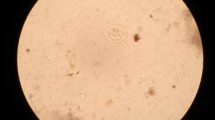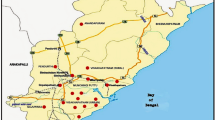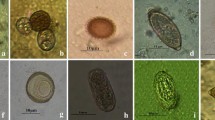Abstract
Studies on the prevalence of gastrointestinal parasites of chicken reared under backyard and intensive systems were carried out in two north Indian states viz., Uttar Pradesh and Uttarakhand. Out of 58 poultry farms screened for gastrointestinal parasites, 81.03 % were positive for Eimeria spp., 15.52 % for Ascaridia galli, 3.45 % for Hetarakis gallinarum, 1.72 % for Syngamus trachea, 5.17 % for Capillaria spp, 1.72 % for Raillietina spp., 1.72 % for Trichostrongylus tenuis, 1.72 % for Choanotaenia infundibulum and 1.72 % for Strongyloides avium. In broiler farms, the prevalence of Eimeria spp. was higher (88.24 %) as compared to layer farms (71.43 %) and backyard poultry (70 %). Identification of Eimeria spp. using COCCIMORPH software revealed prevalence of E. acervulina, E. tenella, E. necatrix, E. mitis and E. praecox in 94.3, 17.14, 31.44, 85.7 and 2.86 % farms, respectively. However, E. maxima and E. brunetti could not be identified in any of the farms using this software. The prevalence of helminthic infections was higher in poultry farms of Uttarakhand (40.0 %) as compared to Uttar Pradesh (11.62 %) with higher prevalence in backyard poultry (36.4 %), followed by layer farms (28.6 %) and lowest in broiler farms (9.1 %). A. galli was the most common G.I. helminth and it was recorded in free-range (backyard poultry) as well as intensive systems (broiler and layer farms).
Similar content being viewed by others
Avoid common mistakes on your manuscript.
India is a livestock dependent country with the animal husbandry sector along with agriculture and fisheries contributing to 5.26 % of the total GDP (Anonymous 2009). Among the diverse animal husbandry practices, poultry farming is the least cost alternative next to fish rearing in the animal husbandry sector. India has one of the world’s largest and fastest growing poultry industry, ranking third in hen egg production and sixth in broiler meat production (USDA 2011). Poultry sector plays an important role in the national and socio-economic development of the country contributing nearly $2.2 billion annually to the national economy (Mohanty and Rajendran 2003). However, the economics of poultry farming may be hampered by frequent outbreaks of diseases due to faulty management of the poultry farms. Of the various infectious diseases, parasitic infections may cause considerable damage and great economic loss to the poultry industry due to malnutrition, decreased feed conversion, weight loss, lowered egg production and death in young birds. The common internal parasitic infections occurring in poultry include cestodes, nematodes and coccidia, with mixed infections being very common (Poulsen et al. 2000). Coccidiosis, ranked second important disease of poultry after salmonellosis, is one of the most dreadful diseases, which affects all age groups while most of the helminthic infections are chronic in nature and affect mainly adult birds.
The prevalence of most of the parasitic diseases in poultry seems to have reduced significantly in commercial poultry production systems due to improved housing, hygiene and management (Permin and Hansen 1998). However, parasitic diseases continue to be of great importance in deep-litter and free-range systems of poultry rearing. The aim of the present study was to determine the prevalence of Eimeria spp. and gastrointestinal helminths in intensive systems as well as free-range chickens in upper gangetic plains of India.
Materials and methods
A total of 58 farms from free-range (backyard poultry) as well as intensive system (broiler and layer farms) were sampled from six districts of Uttar Pradesh and Uttarakhand namely, Bareilly (17 broiler, 3 layer and 5 backyard), Lucknow (4 broiler and 1 backyard), Faizabad (4 broiler and 3 layer), Mathura (2 broiler, 3 layer and 1 backyard), Udham Singh Nagar (4 broiler, 3 layer and 2 backyard) and Dehradun (3 broiler, 2 layer and 1 backyard) during November 2011–April 2012.
Pooled poultry drop**s were collected in 50 ml polypropylene conical tubes containing 5 ml of 2 % potassium dichromate from individual farms starting from one corner of the unit and moving in a ‘W-shaped’ path across the unit, till the tube was filled up to the 10 ml mark. The samples thus collected were transported to the laboratory and kept in refrigerator at 4 °C until further used.
All these samples were screened for coccidian oocysts and helminth eggs by standard salt flotation technique. Oocysts per gram of faeces were determined using McMaster chambers.
For the identification of eimerian oocysts, the photographs of representative numbers of individual sporulated oocysts from each sample were taken at 40× high dry power objective with a photomicrographic camera attached to a trinocular research microscope. The identification of Eimeria spp. of chickens was done by using COCCIMORPH software (a system for Automatic Diagnosis of Coccidia through Morphological Analysis; http://www.coccidia.icb.usp.br/coccimorph/ ). The software was downloaded from the internet and the oocyst images (400×) were uploaded for species identification. The Eimeria spp. identified by the software in each sample was recorded.
Result and discussion
Out of 58 poultry farms screened, 81.03 % were positive for Eimeria spp. oocysts, 15.52 % for Ascaridia galli, 3.45 % for Hetarakis gallinarum, 1.72 % for Syngamus trachea, 5.17 % for Capillaria spp., 1.72 % for Raillietina spp., 1.72 % for Trichostrongylus tenuis, 1.72 % for Choanotaenia infundibulum and 1.72 % for Strongyloides avium eggs (Table 1; Plate 1).
An overall prevalence of 81.03 % of Eimeria spp. infection with a mean OPG of 28044.22 ± 6354.46 (Mean ± S.E.) was recorded in chickens in the areas under study. Higher prevalence of infection in chicken was recorded in Uttar Pradesh (83.72 %) than in Uttarakhand (73.33 %). In U.P., the prevalence of infection was highest in district Bareilly (88.0 %), while it was lowest in district Mathura (66.7 %). In Uttarakhand, the prevalence was higher in district Udham Singh Nagar (88.9 %) as compared to Dehradun (50.0 %). The prevalence in chickens reared under different poultry farming systems is shown in Table 2. It was higher in broiler farms (88.24 %) as compared to layer farms (71.43 %) and backyard poultry (70 %). Mean OPG was highest in broiler farms (40922.79 ± 56235.14) and lowest in backyard poultry (3231.43 ± 3616.55). Depending on the type of poultry production systems, managemental practices, age of birds and climatic conditions, variable prevalence rates of poultry coccidiosis has been reported from various parts of the world including India (Panda et al. 1997; Rana and Tikaram 1999; Jithendran 2001; Al-Natour and Suleiman 2002; Etuk et al. 2004; Ashenafi et al. 2004; Lobago et al. 2005; Khan et al. 2006; Muazu et al. 2008; Nematollahi et al. 2009; Saira Banu et al. 2009; Balasubramaniam and Dorairajan 2009). Contrary to the findings of present study, Saira Banu et al. (2009) reported a moderate prevalence rate in broiler farms (52.1 %), and higher prevalence in layer farms (61.7 %) of Tamil Nadu, India. Higher prevalence of coccidia in layer farms may be because of faulty managerial practices or high density of birds in cages.
Identification of species of Eimeria oocysts by COCCIMORPH software revealed that overall prevalence of Eimeria acervulina, E. tenella, E. necatrix, E. mitis and E. praecox was 77.6, 12.1, 27.6, 70.7, 1.7 %, respectively (Table 3). However, E. maxima and E. brunetti could not be identified in any of the farms. In broilers, E. acervulina (82.4 %), E. tenella (20.6 %), E. necatrix (26.5 %), E. mitis (76.5 %) and E. praecox (2.9 %) could be identified, while in layers and backyard poultry only E. acervulina, E. necatrix and E. mitis could be identified. Identification of Eimeria species can be done by either conventional method or by biochemical and molecular techniques. Conventional methods are tedious, time consuming and needs expertise. An innovative approach that has been tried for identification of eimerian oocysts is a software tool COCCIMORPH (a system for Automatic Diagnosis of Coccidia through Morphological Analysis). In this, digital images from unidentified sporulated oocysts of Eimeria spp. are uploaded and the software analyses the oocyst on the basis of different features namely, curvature characterization, size and symmetry and internal structure characterization for the identification of species of eimerian oocyst (Castanon et al. 2007). In the present study, an attempt was made to use COCCIMORPH software for the identification of oocyst of Eimeria spp. The data on the use of this software for identification of Eimeria spp. is not available and our results show that this method of identification of oocysts has low specificity as many of the oocysts that were microscopically identified on the basis of their size and morphology could not be correctly identified by this software. This was further substantiated by the results of ITS-1 based nested PCR (Lew et al. 2003) which could identify E. acervulina, E. tenella, E. necatrix, E. mitis, E. maxima, E. praecox and E. brunetti in 94.3, 97.2, 68.6, 94.3, 88.6, 80, and 11.4 % farms, respectively (details not presented in this paper). Thus, it is opined that COCCIMORPH may only be used for preliminary screening/identification purposes only.
In the present study, the prevalence of helminth infection was higher in poultry farms of Uttarakhand (40.0 %) as compared to Uttar Pradesh (11.62 %). Also, the prevalence of helminthic infections was highest in backyard poultry (36.4 %), followed by layer farms (28.6 %) and broiler farms (9.1 %). Round worm infection was recorded in 15.5 % farms while tapeworm infection was recorded in 3.4 % farms screened. Mixed infections of nematodes were recorded in 8.6 % poultry farms screened, while A. galli infection was recorded in 6.9 % farms only. Higher prevalence of G.I. helminths in backyard poultry is expected as the birds are reared for longer duration and are allowed for scavenging for most of the days, and thus are more frequently exposed to infective stages/infected intermediate hosts of the helminths. In Uttar Pradesh, A. galli was the most common G.I. helminth and it was recorded from free-range (backyard poultry) as well as intensive systems (broiler and layer farms) of poultry rearing. However, H. gallinarum, S. trachea and T. tenuis could be recorded only from layer farms of U.P. In Uttarkhand, eggs of A. galli, H. gallinarum, Capillaria spp, Raillietina spp., T. tenuis, C. infundibulum and S. avium could be recorded. Puttalakshmamma et al. (2008) recorded 52.2 % cestode, 34.3 % nematode and 18.3 % mixed infection of cestodes and nematodes in fowl in and around Bangalore. They also reported prevalence of A. galli, Rallietina tetragona, R. echinobothrida, H. gallinarum, Subulura spp. and S. avium in the birds screened on post mortem examination. Katoch et al. (2012) also reported high prevalence of helminths in poultry (72.0 %) and A. galli was most prevalent, followed by H. gallinarum, R. cesticillus, R. echinobothrida, H. gallinarum and Capillaria spp. Mild infection of helminths often goes unnoticed but occasionally may accentuate heavy burden leading to reduced egg production, feed conversion and occasional mortality. Thus, continuous surveillance and systematic deworming is essential for profitable poultry rearing.
On the basis of findings of the present study, it is concluded that gastrointestinal parasitic infections, especially poultry coccidiosis, still remain as a major hurdle against profitable poultry production in poultry producing belts of north India and necessary preventive and control measures should be implemented strictly by poultry producers of these states.
References
Al-Natour MQ, Suleiman M (2002) Flock–level prevalence of Eimeria species among broiler chicks in northern Jordan. Prev Vet Med 53:305–310
Anonymous (2009) Agriculture. In: India 2009–a reference annual, 53rd edn. Publications Division, Ministry of Information and Broadcasting, Government of India, New Delhi, pp 57–109
Ashenafi H, Tadesse S, Medhin G, Tibbo M (2004) Study on coccidiosis of scavenging indigenous chickens in central Ethiopia. Trop Anim Health Prod 36:693–701
Balasubramaniam A, Dorairajan N (2009) Influence of season on occurrence of poultry diseases in Namakkal region of South India. Indian J Anim Sci 4:27–29
Castanon CAB, Fernandez S, Fraga JS, Fontoura LF, Gruber A (2007) COCCIMORPH: a real-time diagnostic tool based on automatic image recognition of protozoan parasites of the genus Eimeria. In: Proceedings of the world association for the advancement of veterinary parasitology, Gent 19–23 August 2007
Etuk EB, Okoli IC, Uko MU (2004) Prevalence and management issues associated with poultry coccidiosis in Abak agricultural zone of Akwa Ibom State, Nigeria. Int J Poult Sci 3:135–139
Jithendran KP (2001) Coccidiosis—an important disease among poultry in Himachal Pradesh. ENVIS Bull 9:2
Katoch R, Yadav A, Godara R, Khajuria JK, Borkataki S, Sodhi SS (2012) Prevalence and impact of gastrointestinal helminths on body weight gain in backyard chickens in subtropical and humid zone of Jammu, India. J Parasit Dis 36:49–52
Khan MQ, Irshad H, Anjum R, Jahangir M, Nasir U (2006) Eimeriosis in poultry of Rawalpindi/Islamabad area. Pak Vet J 26:85–87
Lew AE, Anderson GR, Minchin CM, Jeston PJ, Jorgensen WK (2003) Inter- and intra-strain variation and PCR detection of the internal transcribed spacer 1 (ITS-1) sequences of Australian isolates of Eimeria species from chickens. Vet Parasitol 112:33–50
Lobago F, Worku N, Wossene A (2005) Study on coccidiosis in Kombolcha poultry farm, Ethiopia. Trop Anim Health Prod 37:245–251
Mohanty S, Rajendran K (2003) 2020 vision for Indian poultry industry. Int J Poult Sci 2:139–143
Muazu A, Masdooq AA, Ngbede J, Salihu AE, Haruna G, Habu AK, Sati MN, Jamilu H (2008) Prevalence and identification of species of Eimeria causing coccidiosis in poultry within Vom, Plateau State, Nigeria. Int J Poult Sci 7:917–918
Nematollahi A, Moghaddam Gh, Pourabad RF (2009) Prevalence of Eimeria species among broiler chicks in Tabriz (Northwestern of Iran). Munis Entomol Zool 4:53–58
Panda DN, Mishra A, Mishra SC, Panda BK (1997) Incidence of coccidiosis in broiler birds in and around Bhubaneswar, Orissa. Indian Vet J 74:430–431
Permin A, Hansen JW (1998) The epidemiology, diagnosis and control of poultry parasites. FAO animal health manual, no. 4. Food and Agriculture Organization of the United Nations, Rome, p 160
Poulsen J, Permin A, Hindsbo O, Yelifari L, Nansen P, Bloch P (2000) Prevalence and distribution of gastrointestinal helminths and haemoparasites in young scavenging chickens in upper eastern region of Ghana, West Africa. Prev Vet Med 45:237–245
Puttalakshmamma GC, Ananda KJ, Prathiush PR, Mamatha GS, Rao S (2008) Prevalence of gastrointestinal parasites of poultry in and around Bangalore. Vet World 1:201–202
Rana N, Tikaram SM (1999) Comparative evaluation of some epidemiological parameters in coccidiosis in broiler chickens. Indian Vet J 76:382–384
Saira Banu S, Raman M, Gomathinayagam S, Dhinakar Raj G (2009) Preponderance of Eimeria species in commercial poultry in Tamil Nadu. Indian J Anim Sci 79:164–166
USDA (2011) India’s poultry and egg industry. In: International egg and poultry review, USDA Agriculture Marketing Service, vol. 14, no. 34
Acknowledgments
Authors are thankful to the Director, Indian Veterinary Research Institute, Izatnagar for providing necessary facilities. The financial assistance provided by DFID and BBSRC, U.K. in the form of CIDLID project on “Anticoccidial vaccine development: the importance of genetic diversity and delivery strategy” is also duly acknowledged. Thanks are also due to the Officer Incharges of various government poultry farms and to the private poultry farmers for their co-operation in sample collection.
Author information
Authors and Affiliations
Corresponding author
Rights and permissions
About this article
Cite this article
Kumar, S., Garg, R., Ram, H. et al. Gastrointestinal parasitic infections in chickens of upper gangetic plains of India with special reference to poultry coccidiosis. J Parasit Dis 39, 22–26 (2015). https://doi.org/10.1007/s12639-013-0273-x
Received:
Accepted:
Published:
Issue Date:
DOI: https://doi.org/10.1007/s12639-013-0273-x





